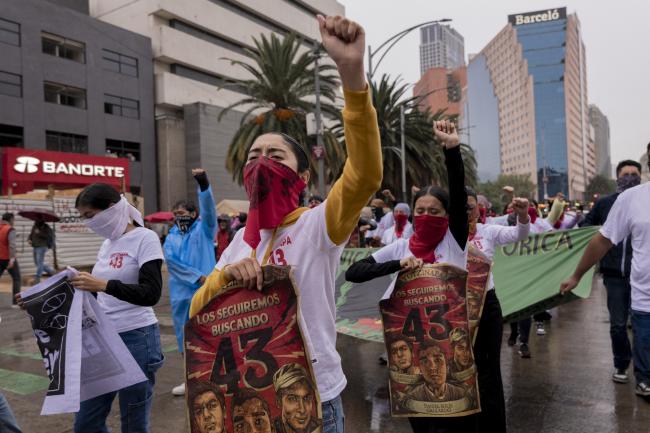by LUCIA CHOLAKIAN HERRERA

Hundreds of teachers’ college students make their way through the streets of Mexico City, chanting and marching in unison. Half-covered by bandanas, their faces reveal piercing eyes, defiant as they walk along Reforma Avenue heading towards the Zócalo, the city’s central square.
They howl together, a guttural, deafening chorus that drowns out the noise of Mexico City: “Alive they took them, alive we want them.”
A decade after the case sent shockwaves across Mexico and beyond, the fate of the students remains shrouded in silence.It is September 26, 2024, on the fourth consecutive day of mobilizations in the capital, just hours before the 10-year anniversary since 43 normalistas from the Ayotzinapa Rural Teachers’ College were forcibly disappeared. A decade after the case sent shockwaves across Mexico and beyond, the fate of the students remains shrouded in silence. The disappeared were young men just like the demonstrators that fill the city streets, their lives violently suspended in time and place.
A few days later, on October 1, Claudia Sheinbaum will be sworn in as Mexico’s first woman president. A protege of outgoing President Andrés Manuel López Obrador, she was elected in June with nearly 60 percent of the vote. On the Ayotzinapa anniversary, Sheinbaum promised to work with the families of the victims to uncover the truth. Yet, her commitments echo the unfulfilled promises of her predecessor, and it remains to be seen how she will address Mexico’s crisis of disappearance.
The “Historical Truth”
Ayotzinapa remains an inconvenient truth, an open wound in the Mexican psyche. On that fateful night in 2014, five buses carrying students were attacked by municipal and federal police, the army, and organized crime groups in Iguala, in the state of Guerreo. The assault left six dead and 43 missing, igniting national and international outrage in a nation where mass graves have become all too common. An estimated 100,000 people are missing across Mexico, a grim statistic that reflects a deepening forensic crisis.
The investigation has faced a decade of obstruction and deceit, with officials manipulating narratives to shield those responsible. In 2015, the Attorney General’s Office attempted to close the case by installing a “historical truth,” asserting that the students were intercepted by members of the cartel Guerreros Unidos, killed, and incinerated in a garbage dump 15 miles away. Established through state torture and the fabrication of evidence, this narrative systemically erased the role of the Mexican military and police in perpetrating the crime.
However, family members of the disappeared, experts like the Argentine Forensic Anthropology Team, and investigative journalists—including Marcela Turati, Pepe Jimenez, and John Gibler—refused to accept this false narrative. They tirelessly retraced the events and pressured authorities to reopen investigations that linked the case directly to higher authorities, including top military officials.
AMLO’s Unfulfilled Promises
When Andrés Manuel López Obrador (AMLO) took office in 2018, he promised to prioritize uncovering the truth behind Ayotzinapa. Two days after his inauguration, he signed an executive order creating a new commission to investigate the case and invited back the Interdisciplinary Group of Independent Experts (GIEI), a committee of international specialists formed by the Inter-American Commission on Human Rights, which had been expelled by the administration of Enrique Peña Nieto in 2016.
“He told us we were going to know the truth about what happened to our kids,” says Francisco Lauro Villegas, the father of one of the missing students, at the anniversary protest in Mexico City. Yet six years later, that promise remains unfulfilled. The investigation stalled when it revealed evidence of top military involvement, a line that many observers believe AMLO could not—or would not—cross.
